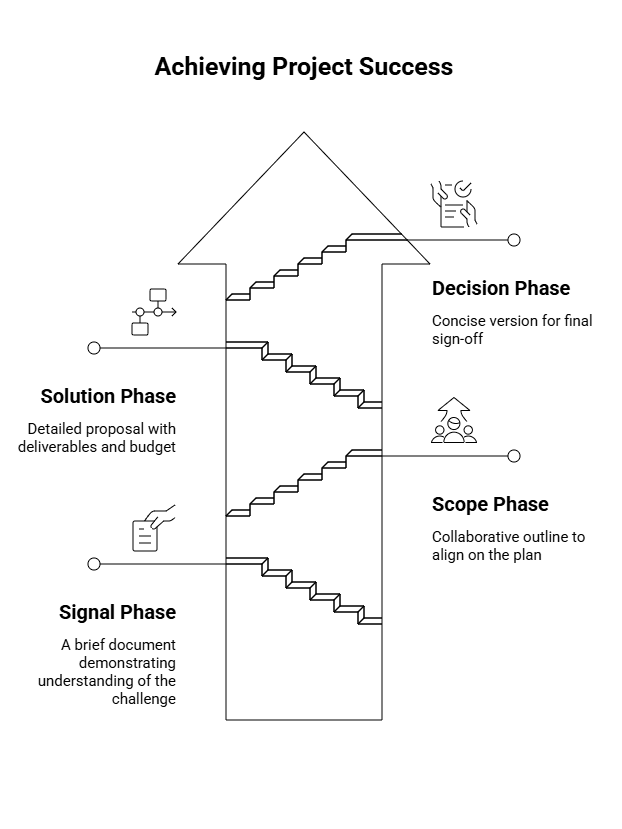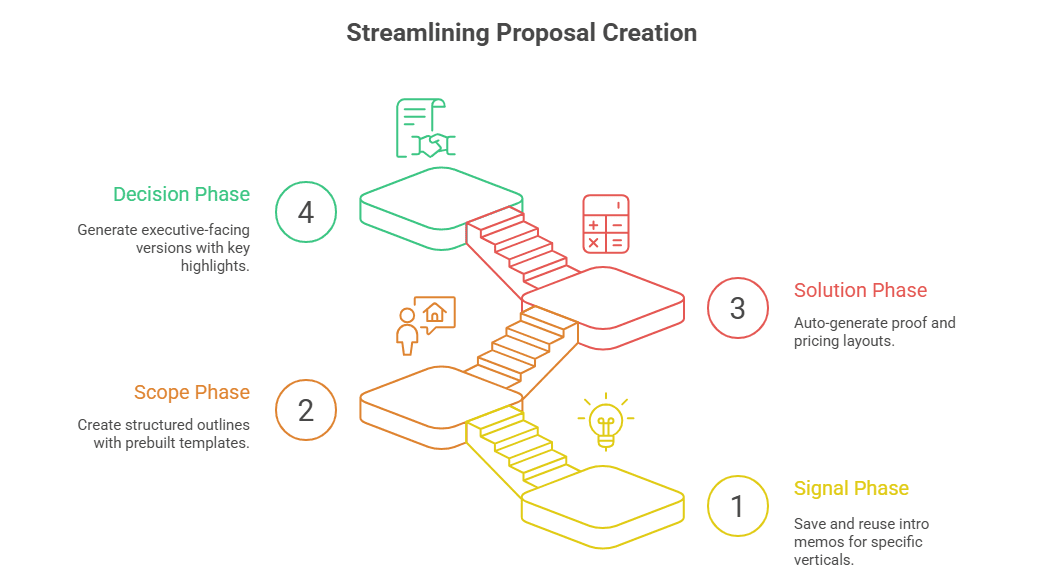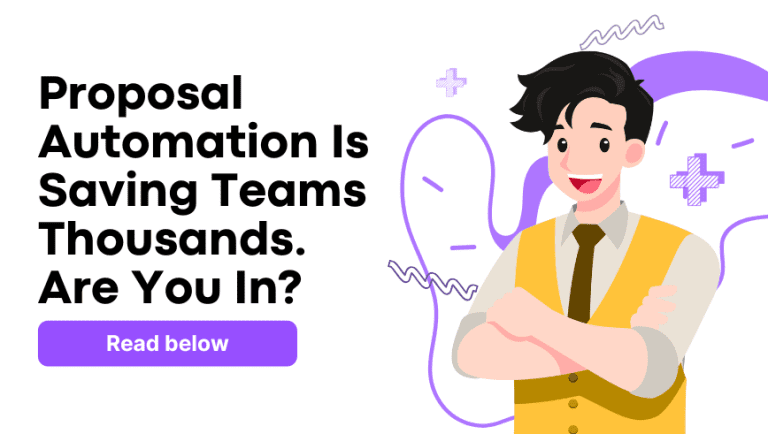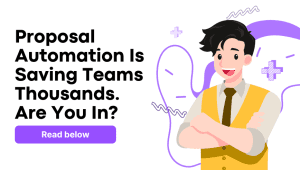لنكن صريحين. لينكدإن مليء بالنصائح. لكن الصفقات المعقدة تحتاج إلى أكثر من مجرد استراتيجية تقدمها منشورات ذكية.
"لا ترسل أبدًا اقتراحًا مكونًا من 40 صفحة مرة أخرى."
"أغلق بشكل أسرع بثلاث شرائح فقط."
توقف عن الترويج. ابدأ بسرد القصص.
لقد رأينا جميعًا منشورات كهذه. تحظى بإعجابات، وتُثير نقاشات. ولكن عندما تعمل على طلب عروض أسعار بمبالغ ضخمة مع خمسة من صناع القرار، فليس من السهل تطبيق أيٍّ من هذه النصائح. الجميع يتحدث عن... أفضل ممارسات الاقتراح. قليلون هم من يفسرون كيفية جعلهم يعملون في دورات المبيعات المعقدة متعددة المراحل.
هذا هو المكان الذي استراتيجية الاقتراح متعدد المراحل الأمر لا يتعلق بجذب الانتباه، بل بتوجيه القرارات. وهذا يتطلب أكثر من مجرد فيلم وثائقي جذاب، بل يتطلب هيكلة وتسلسلًا وطريقة لإظهار القيمة قبل طلب الالتزام.
دعونا نوضح كيف يعمل هذا ولماذا يكون أذكى كاتبي المقترحات على LinkedIn على حق، حتى لو كانت منشوراتهم لا تقول الشيء الكامل دائمًا.
لماذا لا تنجح معظم استراتيجيات الاقتراح في المشاريع المعقدة
لا تزال العديد من الفرق تتبع نهجًا أحاديًا. اقتراح واحد طويل، مُصمم للقيام بكل شيء: التثقيف، والإقناع، والتبرير، والختام.
ولكن في الفرص الكبيرة والمتعددة الطبقات، فإن هذا النهج يتعثر.
يرى كل صاحب مصلحة مخاطر مختلفة. لكل فريق داخل مؤسسة العميل أهداف مختلفة. يريد قسم المشتريات الامتثال، ويريد قسم العمليات الثقة، ويريد المدير المالي الوضوح.
اقتراح واحد لا يُخاطب الجميع في آنٍ واحد. لهذا السبب، استراتيجيات الاقتراح لا تفشل في البيئات المعقدة. ما تحتاجه هو حل تدريجي، مرن، مصمم ليتطور مع تطور المشروع.
ما الذي يبحث عنه صناع القرار فعليًا في مقترحات المشاريع المعقدة
يُركز معظم كاتبي المقترحات على الوضوح والتنسيق. هذا مفيد، لكن صناع القرار يهتمون بأمر آخر أولًا: تنسيق.
قوي استراتيجية الاقتراح لا يقتصر الأمر على عرض عرضك فحسب، بل يُظهر أيضًا فهمك للمخاطر وسياقها وجدولها الزمني. وهذا مهم بشكل خاص في إدارة المشاريع المعقدةحيث تؤثر طبقات متعددة من الإدخال على المكالمة النهائية.
يصبح اقتراحك أقوى عندما يصل إلى القارئ أينما كان. هذا يعني أن الملخص التنفيذي مهم. وهذا يعني أن إطار عائد الاستثمار ليس مجرد خط، بل هو دافع للاستمرار.
ما هي أنواع المشاريع التي تُعتبر معقدة ولماذا تحتاج إلى استراتيجية؟
لا يتطلب كل مقترح هيكلًا من أربع مراحل. ولكن عندما يتضمن المشروع أكثر من فريق، أو أكثر من هدف، أو يؤثر بشكل كبير على عمليات العميل أو سمعته، فإنه ينتقل إلى مرحلة "التعقيد".
إليك كيفية التعرف عليه:
العلامات الشائعة للمشروع المعقد:
- يتضمن 3+ من صناع القرار أو الأقسام
- يتطلب موافقة أصحاب المصلحة الداخليين بما يتجاوز نقطة اتصال واحدة
- لديه احتياجات تنظيمية أو امتثالية عالية
- يتضمن تسليمات مخصصة أو تنفيذًا أو تكاملات
- يتضمن نتائج طويلة الأجل أو الدعم بعد البيع
- الميزانية أعلى من $50,000 أو تعتمد على المعالم
وفقًا لـ Hubspot، تتضمن صفقات مبيعات المؤسسة خمسة من صناع القرار على الأقل.وتفيد شركة Salesforce أن متوسط دورة المبيعات للصفقات المعقدة بين الشركات هو أطول من المعاملات القياسيةمشاركة العديد من أصحاب المصلحة وصناع القرار، وارتفاع متوسط أحجام الصفقات، وإجراءات الشراء المعقدة، والتأثير الكبير لهذه المشتريات والحلول على منظمة المشتري.
لهذا السبب قوي استراتيجية الاقتراح إنها تحول العملية الطويلة والمربكة إلى عملية يمكن التحكم فيها على مراحل.
كيفية الفوز بالمشاريع المعقدة باستخدام استراتيجية مقترحات متعددة المراحل
أفضل الفرق لا تُرسل مقترحًا واحدًا، بل تُرسل المقترح المناسب في الوقت المناسب.
وهنا ما هو ذكي استراتيجية الاقتراح متعدد المراحل يبدو مثل:

- مرحلة الإشارة: وثيقة أو مذكرة قصيرة تُبيّن فهمك للتحدي. لا تُسوّق، بل تُحدث صدىً.
- مرحلة النطاق: مخطط تعاوني يُسهم في وضع الخطة. هذا يسمح بالتنسيق قبل تحديد الأسعار.
- مرحلة الحل: المقترح الكامل مع المخرجات والميزانية والإثبات. ينتظرون الآن التفاصيل.
- مرحلة اتخاذ القرار: نسخة مختصرة ومُصممة خصيصًا للتوقيع النهائي. تركز على الثقة أكثر، وليس على الميزات.
كل مرحلة تُعزز الزخم، وتُقلل الاحتكاك، وتُضمن أن تعكس استراتيجية عرضك كيفية شراء العميل، وليس فقط كيفية بيعك.
تصميم استراتيجية الاقتراح الخاصة بك بما يتناسب مع نوع المشروع المعقد
لا تتبع جميع المشاريع المعقدة نفس الإيقاع. قد تفشل استراتيجية مقترحة ناجحة لطلب عروض أسعار حكومي في دورة مبيعات سريعة لبرمجيات كخدمة (SaaS).
فيما يلي كيفية تكييف استراتيجية اقتراحك بناءً على طبيعة المشروع:
لحلول SaaS وحلول التكنولوجيا B2B
غالبًا ما يُقيّم المشترون بناءً على توافق خارطة الطريق، والدعم المستقبلي، وإمكانية التوسع. استخدم مرحلة الإشارة لإظهار محاذاة حالة الاستخدام، والحفاظ على مرحلة النطاق مرن. أصحاب المصلحة هنا يحبون المرئيات والقابلية للمقارنة ودورات التكرار القصيرة.
للمشاريع الإبداعية والاستشارية والعلامات التجارية
تعتمد هذه المشاريع بشكل كبير على التفسير والوضوح والنهج. استخدم مرحلة النطاق للتوافق مع الذوق والنغمة. مرحلة الحل يجب أن يُظهر منطق العملية والمراجع. شهادات العملاء لها وزن كبير هنا.
للمشاريع الحكومية أو المشاريع التي تتطلب الامتثال بشكل كبير
ابدأ بنية واضحة في مرحلة الإشارةبما في ذلك الوعي باللوائح. ثم قم بتحميل المهام والجداول الزمنية في وقت مبكر من مشروعك. مرحلة الحل. الرسمية مهمة هنا، لكن التسلسل يساعد على تقليل الإرهاق. من المفيد اتباع الاستراتيجية الصحيحة من البداية.
للأعمال الهندسية أو التنفيذية
استخدم مرحلة النطاق لتحليل الجدوى. أضف المخاطر، وتدابير السلامة، والافتراضات إلى مرحلة الحلوهذا يبني المصداقية ويجعلك متميزًا عن الردود العامة.
يتطلب كل نوع من المشاريع نهجًا وتسلسلًا مختلفين، لكن استراتيجية الاقتراح متعددة المراحل تتكيف معها جميعًا. وهذا ما يجعلها نهجًا قابلًا للتطوير.
أفضل ممارسات الاقتراح التي ستسمعها على LinkedIn (ولماذا تعمل بهذا الشكل)
بعض من أكثر المواضيع المشتركة نصائح لكتابة المقترحات قد يبدو الأمر مُبسَّطًا للغاية على الإنترنت، لكن الأمر يبدو منطقيًا ضمن عملية مُتدرِّجة.
- "لا تشرح أكثر من اللازم". هذا أمر سهل عندما تكون مستندك الأول عبارة عن مذكرة إشارة، وليس الاقتراح الكامل.
- "أضف الدليل الاجتماعي". هذا الأمر ينتمي إلى مرحلة الحل، بعد تأمين الفائدة.
- "تحدث مباشرةً مع المشتري". هذا هو الهدف من مستندات مرحلة اتخاذ القرار.
هذه النصائح التي تبدو بسيطة مفيدة أفضل ممارسات الاقتراح عندما يتم تطبيقه بالترتيب الصحيح، هذه هي قوة استراتيجية الاقتراح متعدد المراحل. إنه يجعل كل أفضل الممارسات منطقية.
أفضل الممارسات لكتابة مقترحات الأعمال التي تحقق تحويلًا فعليًا
عندما تبدأ بالتفكير على مراحل، يصبح كل شيء أكثر وضوحا.
هنا ثبت أفضل الممارسات لكتابة مقترحات الأعمال التي تتوافق مع كيفية اتخاذ الفرق الكبيرة قراراتها:
- ابدأ بالأهمية، وليس بالتفاصيل
- استخدم مستندات أقصر ومقسمة إلى وحدات لكل مرحلة
- مطابقة الرسائل مع عقلية القارئ الحالية
- قم بإدراج شهادات فيديو قصيرة بالقرب من التسعير إذا كان ذلك ممكنًا
- أنهي الأمر دائمًا بخطوات واضحة ومختصرة
الأهم من ذلك، جعل كل نقطة اتصال جزءًا من استراتيجية الاقتراح، وليس مجرد مستند ترسله من باب العادة.
كيف تساعدك أدوات كتابة المقترحات على الالتزام باستراتيجيتك متعددة المراحل
حتى الفرق التي تؤمن بنموذج متعدد المراحل غالبًا ما تواجه صعوبات في التنفيذ. فبدون نظام مُطبّق، من السهل الاكتفاء بإرسال مستند ضخم واحد على أمل أن ينجح.
هذا هو المكان الذي أداة كتابة المقترحات الصحيحة يحدث فرقا.
فيما يلي كيفية مساعدة أدوات مثل Proposal.biz في تنفيذ الاستراتيجية في كل مرحلة:
الدعم مرحلة بمرحلة:

- مرحلة الإشارة
احفظ وأعد استخدام مذكرات تمهيدية خفيفة الوزن تتناول مواضيع أو مشكلات محددة. يتيح لك Proposal.biz اختيار عباراتك أو صيغك التمهيدية الأكثر استخدامًا بنقرة واحدة. - مرحلة النطاق
أنشئ مخططات نطاق عمل منظمة باستخدام قوالب أقسام جاهزة ووحدات سحب وإفلات. تساعد الأدوات الفرق على التحرير المشترك مع أصحاب المصلحة وإنشاء إصدارات مختلفة لكل قسم. - مرحلة الحل
إنشاء نماذج تجريبية وتسعير تلقائيًا بتنسيق ذكي وأصول مدمجة خاصة بالعميل. توفر الفرق ساعات من العمل لكل صفقة. - مرحلة اتخاذ القرار
أنشئ نسخًا واضحةً وموجهةً للتنفيذيين، مع إبراز المخاطر والعوائد والالتزامات. لا حاجة لإعادة الكتابة يدويًا.
وفقا ل تقرير إدارة الاستجابة الاستراتيجية لعام 2025, 62% من جميع الشركات أفادت بنمو في الإيرادات على أساس سنوي مرتبط بشكل مباشر بالتحسينات في عمليات إدارة الاستجابة الاستراتيجية، والتي تشمل تنفيذ الأتمتة الجديدة والذكاء الاصطناعي وتبسيط سير العمل.
عندما تدعم أداتك الاستراتيجية، تصبح أكثر من مجرد أداة لبناء المحتوى، بل نظام تحويل.
كيف يدعم Proposal.biz استراتيجية متعددة المراحل من خلال التصميم
تُعامل معظم أدوات الاقتراح كل شيء كملف واحد. مستند واحد. إرسال واحد.
هذا لا يُجدي نفعًا عندما تحاول الفوز بصفقة متعددة الطبقات. اقتراح.بيزنحن نعمل على بناء منصة تفهم هذا الأمر.
يتيح لك نظامنا:
- إنشاء مراحل متعددة من المقترحات، مرتبطة ولكنها متميزة
- قم بتخصيص كل مرحلة بناءً على من سيقرأها
- تتبع المشاركة حسب القسم، وليس فقط إجمالي الفتحات
- أضف تعليقات الفريق ونصائح كتابة المقترحات أثناء العمل
- استخرج المحتوى ذي الصلة مباشرةً من موقع الويب الخاص بك ومن الانتصارات السابقة
تم تصميمه خصيصًا لعمليات سير المبيعات الحقيقية ويستفيد من أفضل ما تقدمه الذكاء الاصطناعي.
يعتمد موقع Proposal.biz على الاعتقاد بأن الحق استراتيجية الاقتراح يجعل إتمام المشاريع المعقدة أسهل وأسرع وأكثر اتساقًا. ولهذا السبب ابتكرنا أول أداة مقترحات حقيقية تعتمد على الذكاء الاصطناعي. يستفيد من الذكاء الاصطناعي لمساعدة المؤسسات على إنشاء عمليات مبيعات أسرع وأكثر دقة وتظل إنسانية عندما يكون ذلك مهمًا.
كيفية قياس نجاح استراتيجية اقتراحك
استراتيجية الاقتراح الذكية لا تتوقف عند الإرسال، بل تُبقيك على اطلاع دائم بكل مرحلة. إليك كيف تُتابع الفرق عالية الأداء فعاليتها:
عرض الوقت حسب القسم
إذا حصل الملخص التنفيذي على 80% من إجمالي وقت المشاهدة، لكن قسم التسعير حصل على 12%، فأنت تعلم أين تقع القصة وأين قد تفقد زخمها.
الوقت بين المراحل
تشير الفجوات الأقصر بين وثائق الإشارة والنطاق والحل إلى قوة جذب. غالبًا ما يؤدي التأخير الطويل إلى عدم التوافق أو غياب الوضوح.
المشاركة الداخلية
عندما يُطرح اقتراحٌ داخل منظمة العميل، فهذا عادةً ما يكون علامةً على تشكّل إجماع. تُعدّ هذه الخطوة من أهمّ مراحل العمل.
حلقات التغذية الراجعة
إذا استمر العملاء في طلب إعادة الكتابة أو التوضيحات في نفس القسم، فهذه ليست مشكلة تنسيق، بل مشكلة تأطير.
حان وقت اتخاذ القرار
تميل المقترحات متعددة المراحل إلى تقليل وقت اتخاذ القرار بمقدار 18–27% (استنادًا إلى بيانات Proposal.biz المبكرة)، لأن كل خطوة تقود المشتري إلى الاقتراب دون إرهاق.
الأفضل استراتيجيات الاقتراح التعلم والتطور والبيانات هي التي تغذي هذا التطور.
نصائح حقيقية رأيناها تعمل في المقترحات متعددة المراحل
بعض الطرق أفضل من غيرها. إليكم ما رأيناه:
- استخدم وثيقة "نحن نتفهم تحديك" من صفحة واحدة كأول رسالة. سيتم قراءتها.
- أضف جدولًا زمنيًا قابلًا للنقر قبل عرض الأسعار. يُخفف ذلك من حدة النقاش حول الميزانية.
- احرص على أن يكون كل مرحلة أقل من 6 صفحات ما لم يكن القانون يتطلب مدة أطول.
- إذا كان العميل يشارك شرائح داخلية، فقم بعكس مصطلحاته في اقتراحك.
هذه ليست اتجاهات، بل هي اتجاهات راسخة. استراتيجيات الاقتراح بناءً على كيفية تفكير صناع القرار.
ما يخطئ فيه معظم الفرق بشأن استراتيجيات المقترحات متعددة المراحل
تبدو فكرة استراتيجية الاقتراح التدريجي بسيطة. لكن أثناء التنفيذ، تلجأ العديد من الفرق إلى عادات تُعيق إتمام الصفقات.
هنا الأخطاء الشائعة لمشاهدة:
- ضغط كل المحتوى في مستند واحد طويل
حتى لو قمتَ بتقسيمها إلى أجزاء، فإن إرسال كل شيء دفعةً واحدة يُلغي فائدة تنظيم الوتيرة، ويُرهقك بدلًا من أن يُشجّعك. - الكتابة لأحد أصحاب المصلحة بدلاً من مجموعة الشراء
معظم الصفقات المعقدة متعددة الوظائف. ينبغي أن تعكس استراتيجية عرضك ذلك من خلال مواد مُصممة خصيصًا لكل مرحلة. - التعامل مع مرحلة النطاق باعتبارها اختيارية
هذا هو المكان الذي يحدث فيه معظم التوافق. تجاهله أو تجاوزه بسرعة قد يؤدي إلى اعتراضات في المراحل النهائية. - استخدام نفس الهيكل لكل صفقة
يجب أن يكون الهيكل مرنًا بناءً على نوع المشروع وملامح المخاطر ووتيرة قرار العميل. - عدم تتبع أداء الاقتراح
بدون مقاييس، لا يمكنك التحسن. وبدون التحسين، حتى أفضل نصائح كتابة العروض لن تساعدك على التوسع.
قوي استراتيجية الاقتراح الأمر لا يتعلق بما تكتبه بقدر ما يتعلق بمتى ولماذا ترسله.
استراتيجية الاقتراح تتفوق على الأسلوب في المبيعات المعقدة
في عام ٢٠٢٥، من السهل أن تُربكك أدوات وقوالب ونصائح العروض. لكن الحقيقة هي أن الصفقات الكبيرة لا تُبرم بتنسيق ذكي، بل بالوضوح والسرعة والثقة.
قوي استراتيجية الاقتراح يُركز على ما يحتاجه صانع القرار في كل نقطة. من المهم أن تتذكر أن الأمر لا يقتصر على ما تريد قوله فحسب، بل يعكس التوقيت والأهمية والثقة المُهيكلة.
في Proposal.biz، نبني أداتنا بناءً على هذه الفكرة تحديدًا. سيتم إطلاق النسخة التجريبية قريبًا، وجميع الميزات التي صممناها تدعم سير العمل التدريجي، والكتابة الذكية، والتخصيص السريع.
إذا كنت تعمل على مشاريع معقدة، فهذه هي الإستراتيجية التي ستلبي احتياجاتك في مكانها الفعلي.
ونحن نعمل على بناء المنصة لمساعدتك على القيام بذلك.




